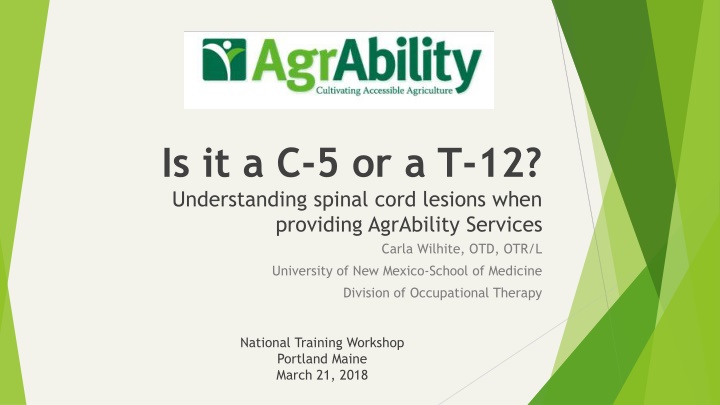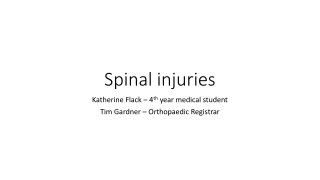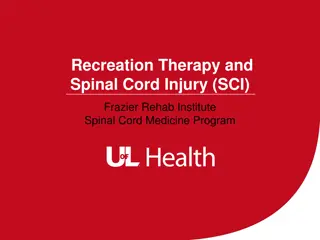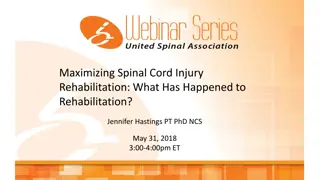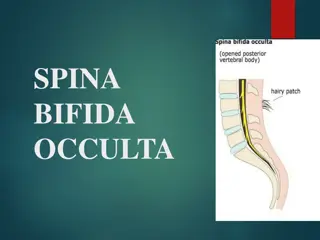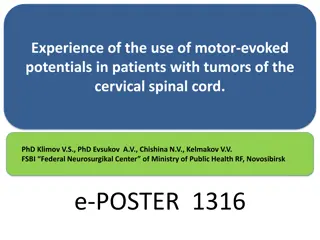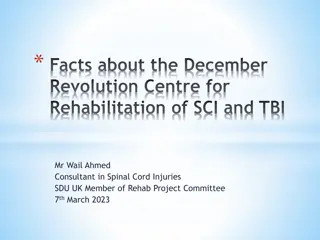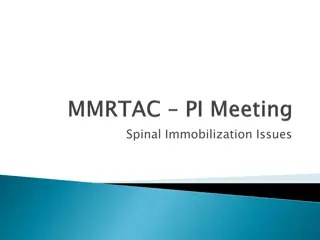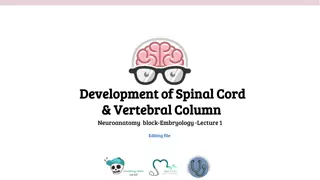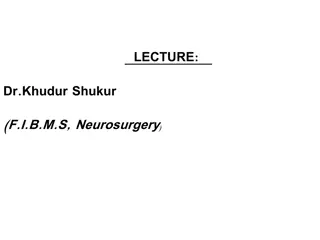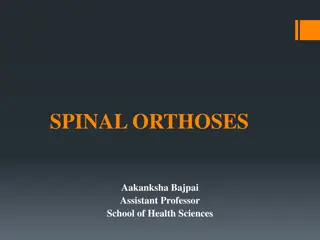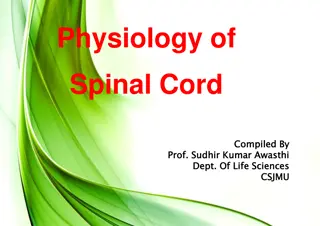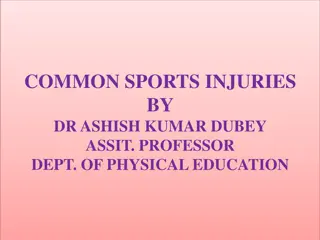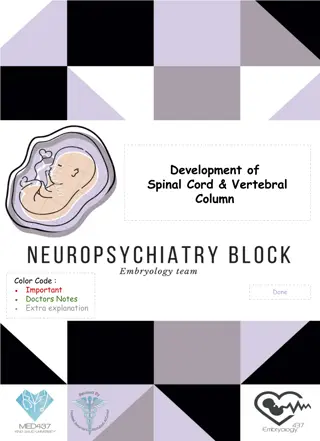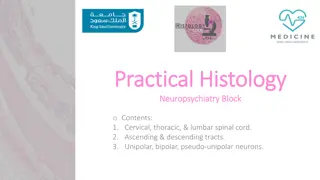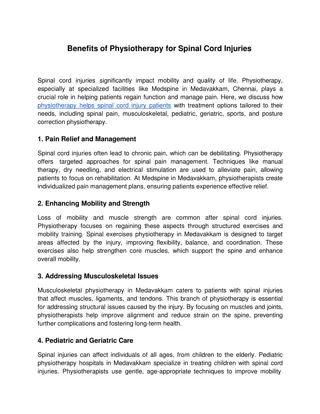Spinal Cord Injuries Overview
This session explores the basic classification of spinal cord injuries, functional implications, major complications, and considerations for redesigning work environments to support individuals with spinal cord injuries in agricultural settings. Understanding the levels of the vertebral column and primary functions of nerves is crucial in providing effective support and solutions for farming and ranching by people with spinal cord injuries.
Download Presentation

Please find below an Image/Link to download the presentation.
The content on the website is provided AS IS for your information and personal use only. It may not be sold, licensed, or shared on other websites without obtaining consent from the author.If you encounter any issues during the download, it is possible that the publisher has removed the file from their server.
You are allowed to download the files provided on this website for personal or commercial use, subject to the condition that they are used lawfully. All files are the property of their respective owners.
The content on the website is provided AS IS for your information and personal use only. It may not be sold, licensed, or shared on other websites without obtaining consent from the author.
E N D
Presentation Transcript
Is it a C-5 or a T-12? Understanding spinal cord lesions when providing AgrAbility Services Carla Wilhite, OTD, OTR/L University of New Mexico-School of Medicine Division of Occupational Therapy National Training Workshop Portland Maine March 21, 2018
Objectives Participants will be familiar with the basic classification of spinal cord injuries (e.g. skeletal level, neurological level, motor level, sensory level, functional level) Participants will understand the major functional implications of SCI lesions (i.e. performing self- care, driving, etc.) Participants will know the major complications of spinal cord injuries (e.g. skin, autonomic dysreflexia, temperature, sun exposure). Participants will consider redesign of the agricultural work environment to support work participation for those with spinal cord injuries.
Statement of the Situation AgrAbility Specialists are often referred to provide services to farmers and ranchers with spinal cord injuries. Lack of knowledge about the level of injury may result in over-estimating or under-estimating the functional performance of the individual, the kinds of supportive technologies needed, or the need for modifications to the environment to support health and participation in agricultural work. This session will make the differences clearer and well-understood, so that effective and efficient solutions are identified to support farming and ranching by people with spinal cord injuries.
Primary functions of the nerves Cervical nerves 1-4- breathing, neck movement 4-6- heart rate, shoulder movements 6-7- wrist, elbow 7-T1-hand, finger movement Thoracic nerves sympathetic system, trunk stability Ejaculation (contributions from lumbar) Lumbar Movement of hip, knee, foot Sacral Bowel and bladder, erection/clitoris
What is a spinal cord injury? A spinal cord injury usually begins with a sudden, traumatic blow to the spine that fractures or dislocates vertebrae. The damage begins at the moment of injury when displaced bone fragments, disc material, or ligaments bruise or tear into spinal cord tissue. Spinal cord injuries are classified as either complete or incomplete. An incomplete injury means that the ability of the spinal cord to convey messages to or from the brain is not completely lost. People with incomplete injuries retain some motor or sensory function below the injury. A complete injury is indicated by a total lack of sensory and motor function below the level of injury.
Classification of spinal cord injuries Tetraplegia (aka quadriplegia) Neurological level Lowest segment of the spinal cord at which key muscles have fair or better strength and sensation is intact at the level Impairment in motor/sensory of cervical segments of the cord Paraplegia Functional level (rehab) Impairment in motor/sensory of thoracic, lumbar, sacral segments of the cord Lowest level of the spinal cord at which muscles are fair + or better and sensation is intact Paraplegia spares arm function, and depending on level of lesion: trunk, legs, and pelvic organs Fair plus means the person can move the muscle against gravity: huge implication for function
Health management issues for SCI Respiration Autonomic dysreflexia Orthostatic hypotension/postural hypotension Skin Integrity Bowel and Bladder Temperature regulation Pain Fatigue Spasticity Sexual function DVTs Heterotopic Ossification Psychosocial adjustment
Respiratory issues Complications Breathing Pneumonia Especially cervical injuries Lung Infections C4 injury-diaphragm partially or completely paralyzed (will need a ventilator) Precautions Practice good bronchial hygiene (quad cough) Incentive spirometry Lower cervical and thoracic injuries-may result in paralysis of other breathing muscles of ribs, abdomen, and back Infection control standards
Autonomic Dysreflexia (AD) Injury at T-6 or higher A life-threatening issue Person develops dangerously high blood pressure in response to a noxious stimulus Cause: hyperactivity of the autonomic nervous system If untreated can result in stroke or death Main Symptom: Pounding headache Other signs: heavy sweating, flushed skin, goose bumps, blurry vision, stuffy nose, anxiety, difficulty breathing, chest tightness Take action: Stop activity, check blood pressure If high: sit up with head elevated Loosen clothing or other constriction, check catheter for kinks/folds Seek medical attention
Orthostatic Hypotension: Abnormal Low Blood Pressure Response: Check blood pressure Blood pressure dangerously LOW Lay back down or lower the head of the bed Usually caused by sitting up too quickly Symptoms: light headedness, pale/pallor, visual changes If person is in wheelchair: lift legs, or recline chair Continue to check BP, seek medical assistance Don t leave person unattended
Management Skin integrity Most people with SCI do not have sensory feedback from the body that tells them to move All people with SCI must adhere to a pressure relief schedule Two full minutes of pressure relief every hour when up in WC!!! Person may be capable of leaning forward or side to side or use tilt in space/reclining features of WC Constant pressure from being in a static position can lead to skin breakdown All people with SCI should check or have skin checked every day, especially around bony areas Check back of head, along back, elbows, buttocks, ankles, and heels Skin breakdown can range from redness of skin to down to the bone tissue damage Keep skin dry, stay hydrated, good nutrition, adapted equipment
Bowel and Bladder Management Function of bowel and bladder occurs in the sacral levels Physician will establish the person s appropriate B and B program Nurse does most of the training Remember sacral sparing for incomplete injuries? Person may feel the need to have B and B relief OT supports the acquisition of skills to perform the program Catheterization Digital stimulation If injury is above S2 level, the person loses the ability to void and defecate voluntarily Women have a harder time than men with management of bladder
Pain Very common after SCI Two types of pain: Noxious stimuli (skin tears, inflammation, injury) Nervous system pain (neuropathic: originates in the nervous system) Pain is physical, emotional, and may be felt below level of lesion! Management Medications Positioning for comfort and sleep Staying active Maintaining strength Wheeling chair appropriately
Spasticity and spasms Spasticity is the uncontrolled tightening or contracting of the muscles Management Positioning Range of motion Common in individuals with spinal cord injuries. Medications: muscle relaxants, baclofen, nerve blocks More common in cervical (neck) than thoracic (chest) and lumbar (lower back) injuries . Some spasticity can be useful: for example: eliciting a jerk to straighten a leg to enter pants when dressing self; or for gripping, or for recognizing the bladder is full Spasms are usually triggered by sensory stimuli: touch, infection, irritants Can lead to contractures of joints Looks like: jerkiness, tightness, flexing/bending of arm or leg, hyperactive reflexes
Sexual activity The occupational therapist has a key role: Complete injuries at S2-S5 affect genitourinary system Most people with SCI continue to have a need for physical and emotional intimacy Can recommend environmental supports, positioning, specific strategies, and adaptive equipment Issues for men: capability to achieve an erection For women: fertility, menstruation, menopause The medical team can help each individual work through issues and find solutions
Temperature regulation In spinal cord injury sensation messages of hot/cold are not sent to the brain People with spinal cord injuries can become severely sunburned or frostbitten Normal skin temps are: 36.5 C to 36.9 C or from 97.7 F to 98.4 F Patients with spinal cord injury (SCI) may have abnormal regulation of body temperature or may be less able to respond to changes in the environment. With high-level SCI, the patient may be especially insensitive to changes in heat or cold. Individuals with spinal cord injury from trauma or medical issues will not be able to adjust their body temperature below the level of the injury. They cannot sweat or shiver below the level of injury or adjust capillary flow because the brain does not receive the message that a body temperature correction needs to be made.
DVT and HO Deep vein thrombosis (blood clots) Heterotopic ossification Abnormal bony formation around joints People with SCI at increased risk, secondary to legs being kept in a dependent position and flexed trunk in sitting Occurs in up to 53% of people with SCI Usually appears 1-4 months after injury Most DVTs develop in abdomen or lower extremities Threat of clot dislodging and blocking blood supply to heart/lung/brain Symptoms: warm, swollen extremity, range of motion limitation Caregivers: should be vigilant about checking for signs of DVT: color, size, or temperature of LE Management: daily range of motion, treat spasticity, appropriate positioning in bed and wheelchair, surgery
Psychosocial aspects of SCI After injury Support Large need to depend on others for all care and basic functions Most people with SCI have improved mood and quality of life over time Many people feel confusion, anxiety, loss, hope, grief, depression, and helplessness Those giving support need to foster autonomy of the individual and support person s capacity to be a problem solver Family members and significant others may also feel these emotions Assist the person engage in activities that are meaningful and relevant
Expected Function at Specific SCI Levels: SEE HANDOUT
Assistive technologies, accommodations, and environmental modifications for farming with SCI
